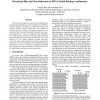Free Online Productivity Tools
i2Speak
i2Symbol
i2OCR
iTex2Img
iWeb2Print
iWeb2Shot
i2Type
iPdf2Split
iPdf2Merge
i2Bopomofo
i2Arabic
i2Style
i2Image
i2PDF
iLatex2Rtf
Sci2ools
ICCAD
1996
IEEE
1996
IEEE
Directional bias and non-uniformity in FPGA global routing architectures
This paper investigates the effect of the prefabricated routing track distribution on the area-efficiency of FPGAs. The first question we address is whether horizontal and vertical channels should contain the same number of tracks (capacity), or if there is a density advantage with a directional bias. Secondly, should the channels have a uniform capacity, or is there an advantage when capacities vary from channel to channel? The key result is that the most area-efficient global routing architecture is one with uniform (or very nearly uniform) channel capacities across the entire chip in both the horizontal and vertical directions. Several non-uniform and directionally-biased architectures, however, are fairly area-efficient provided that appropriate choices are made for the pin positions on the logic blocks and the logic array aspect ratio.
| Added | 07 Aug 2010 |
| Updated | 07 Aug 2010 |
| Type | Conference |
| Year | 1996 |
| Where | ICCAD |
| Authors | Vaughn Betz, Jonathan Rose |
Comments (0)

